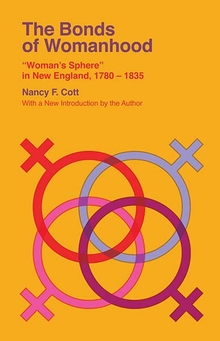Nancy F. Cott—
As family-centered production gave ground to market-oriented production and individual wage earning, school-teaching became a more important financial resource for young women. Both common schools and private seminaries and academies multiplied during the early national period, creating more frequent opportunities for employment. During the early decades of the nineteenth century young women found teaching jobs of at least three kinds. First was traditional summer school teaching, which was becoming more regularized as school boards pursued professionalism, licensing, and economy, but still retained elements of flexibility and casualness. On April 7, 1817, Amanda Elliott, thirty years old and the youngest of eleven siblings of a Guilford, Connecticut, family, noted “some talk that I should take a school.” Twelve days later she recorded, “I determined on taking a school for a quarter,” and on May 4, with some irony, “this day opened my school and should be glad were it the day that clos’d it; excellent feeling for the beginning of a three month job.” She took schools at the same season in 1819 and 1820, nonetheless. Eighteen-year-old Eunice Wait left her “common labours & domestic avocations” at home in Hallowell, Maine, to teach school for the summer in Gerry, fifteen miles away, in 1821. Pamela Brown of Plymouth Notch, Vermont, accepted when, in May 1836, “Mr. Green came and engaged me to teach school in his district for three months. I am to have a dollar a week and to begin next week.” Her school went on until the end of August.
Because of the repeated religious revivals of these decades and ministers’ accompanying emphasis on the formative years of youth, some pious young women took school-teaching responsibilities with new, religious seriousness. A minister’s daughter began her third season of teaching in May 1821 by noting “when I look around on 30 children whose minds are susceptible of any impressions, either good or bad, I almost shrink at the task which devolves on me.” A few days later she recorded, “Have felt very anxious for my little flock this day—How great are the duties incumbent upon an instructor of youth—Impressions made on young and tender minds often remain indelible.” Her anxieties did not subside until the end of June.
Another kind of teaching opportunity existed in the growing numbers of academies for girls. Some academies offered “accomplishments” such as fancy needlework, foreign languages, music, and painting, while others attempted a literary education. Lucinda Read followed a common course when she left her family’s farm in Greenfield, Vermont, at eighteen, went to Canton, Connecticut, to attend an academy, and shortly afterward (1816) secured a job teaching in its lower school. She subsequently taught m Plainfield, New Hampshire, and Montpelier, Vermont. Attending an academy was generally the appropriate preparation for teaching in one. Eliza Perkins, who had been to school in Hartford, Connecticut, left to teach at the Greenfield Female Academy in 1819. She complained that she could “barely get a support” there, however, and considered going South to become a private tutor in a family.
Although women were not well paid for teaching they continued to seek it as respectable and intellectual work. Since women commanded a much lower salary than men, school districts under pressure of population and common-school expansion began to turn to them for regular winter term instruction. This third kind of teaching job became available to women in the 1830s, setting them before classes of girls and boys in their teens. Pamela Brown not only taught in the summer of 1836; between January and March she taught in another school district at the higher rate of $1.50 per week. Her older sister Sally had taught in that district during December and January 1834-35. Mary Hall of Concord, New Hampshire, taught a district school for a brief winter session in 1829-30 after she had attended nearby Brackett Academy for four quarters. Rachel Stearns, in her mid-twenties, moved from Greenfield to Leominster, Massachusetts, to teach a district school for the winter term in 1834-35. She relied on her Methodist beliefs to give her the courage to speak at the head of a class that included “three great boys.” Between 1825 and 1860, according to a recent inquiry, a quarter of all native-born New England women were schoolteachers for some years of their lives.
The growth of schoolteaching provided one instance of the expansion of non-domestic occupations for women. In the late eighteenth century, young women found their chief social usefulness and most remunerative work in households-their own or other families’. But as population expansion, improvements in transportation, and the spur of merchant capitalism allowed market-oriented production to flourish, the importance of young women’s traditional work in household manufacture diminished. Specialized production for commercial exchange was the rising norm. Industrialization, a giant step in this process, occurred first in textile manufacture, which was originally women’s-and especially unmarried women’s household work.
From The Bonds of Womanhood by Nancy F. Cott. Published by Yale University Press in 2021. Reproduced with permission.
Nancy F. Cott is Jonathan Trumbull Research Professor of American History at Harvard University. She is also the author of The Grounding of Modern Feminism, published by Yale University Press.



 Deobandism, Islam and the Religious Narratives of the Taliban
Deobandism, Islam and the Religious Narratives of the Taliban